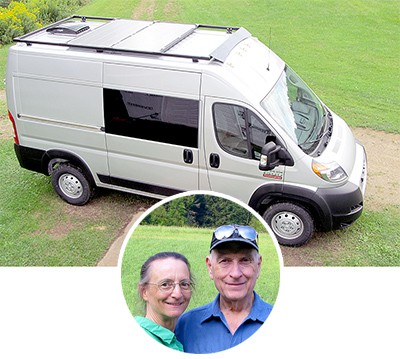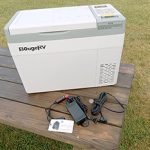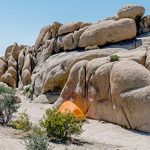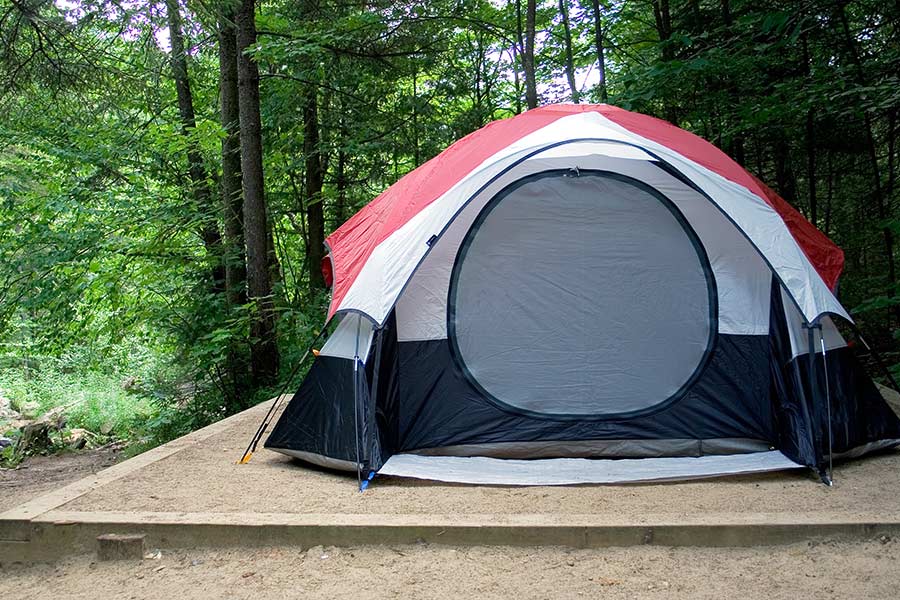
When you’re new to camping, there are a lot of terms people use that you’ve probably never heard of before. One example is a tent pad. Is this something you can bring along with you? You may also notice that some campgrounds specify that they have tent pads while others do not. Do you need a tent pad, and what exactly are they?
A tent pad is a designated flat place to pitch your tent at a campsite. The tent pad will often be slightly raised to account for sloping ground, have some type of border around it, and be filled with gravel or dirt.
Although it is not necessary to use a tent pad when sleeping in a tent, it is convenient and will help you get a better night’s sleep. Let’s look into why it’s good to find a campground with a tent pad if you will be pitching a tent.
Tent Pads – All You Need to Know
Tent pads make your life easier but are not a necessity when camping. All the tent pad does is designate a specific area to pitch your tent. This area will typically be the best place to pitch your tent at a campsite since the pad has been designed to be flat.
You will no longer have to search the site to find that flattest area, and you won’t have to do any work as the pad is all ready to use. Using a tent pad eliminates pitching your tent on roots, debris, or uneven ground.
A tent pad is usually made of dirt and gravel, surrounded by a wooden frame to contain the material. The wood frame is made so that the surface will be level when the inside is filled with dirt or gravel, plus it keeps the filler contained.
Depending on how sloped or rooted the ground is, the tent pad may be raised or even with the ground around it. Sometimes, grass seed is planted on the tent pad’s surface, although grass typically becomes trampled, especially at a well-used campsite.
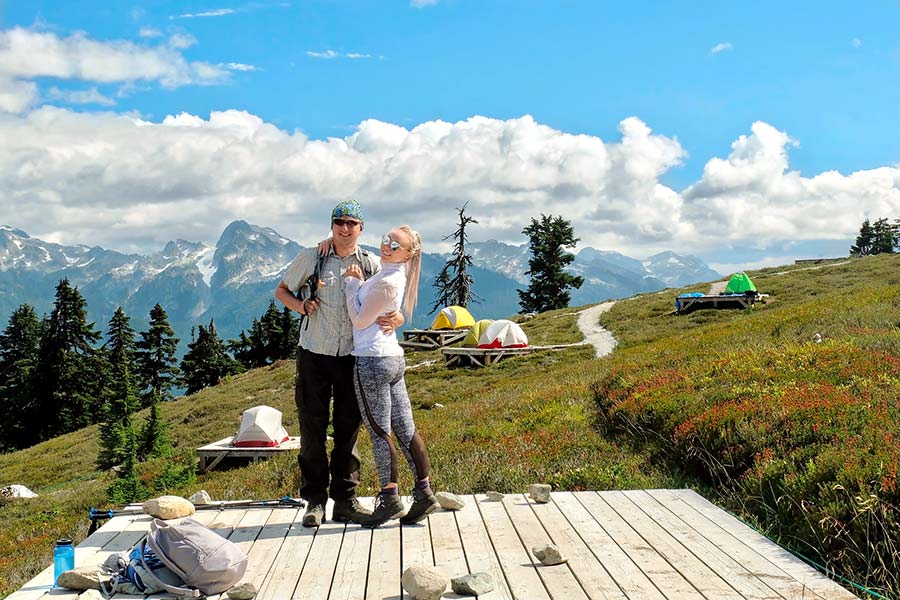
Occasionally, tent pads will be a level wooden platform. This raised area creates a flat, even surface to pitch your tent on. The platform works well when it is not windy, and you do not need to stake down your tent. Otherwise, you have to extend your guy lines to be able to reach the ground or tie them to a tree or edge of the platform.
Typically, a tent pad is about 10 feet by 12 feet. This size gives you an area large enough to fit two small tents or one large family-sized tent. Of course, the tent pad size will vary from campsite to campsite.
If you have concerns about whether your tent will fit, measure the base area at home. You may be able to look up the tent pad’s size at a campground on their website before you go.
How to Use a Tent Pad
Using a tent pad is easy. Simply pitch your tent as you usually would, but within the perimeter of the tent pad to ensure you are on even ground. Since the tent pad area is man-made, the ground is usually softer and, therefore, easier to get tent stakes in.
If you are using a rainfly on your tent, it is best to stake the guy lines within the tent pad’s perimeter. When you are on a raised tent pad, it will be much easier to stake everything in at the same level.
If the tent pad you pitch your tent on is even with the ground around it, this will help eliminate tripping hazards. When all your lines are contained within the perimeter of the tent pad, you will know where the boundary is to walk safely in the dark so you don’t trip.
Related Posts
- Van Camping vs. Tent Camping: What Is Better for You?
- Can You Pitch A Tent On Gravel?
- Can You Use a Tarp as a Tent Footprint?
- Can You Sleep In Your Car Or Van At A Campsite?
Do You Need a Tent Pad?
You do not need a tent pad to camp, and unfortunately, it is not something you can bring with you. If no tent pad is available, you will have to do the work yourself to find the best spot to pitch your tent. Look for a clearing that is flat with as few rocks and roots as possible. Depending on how often a campsite gets used, you may have to do some rock or stick clearing from the spot you pick.
However, if there is a tent pad at the campsite you are staying at, it is best to use the tent pad. The pad will be the best spot to pitch your tent at that particular site. You may have to move a few stray sticks and rocks, but ultimately this is the best tent spot.
Benefits of a Tent Pad
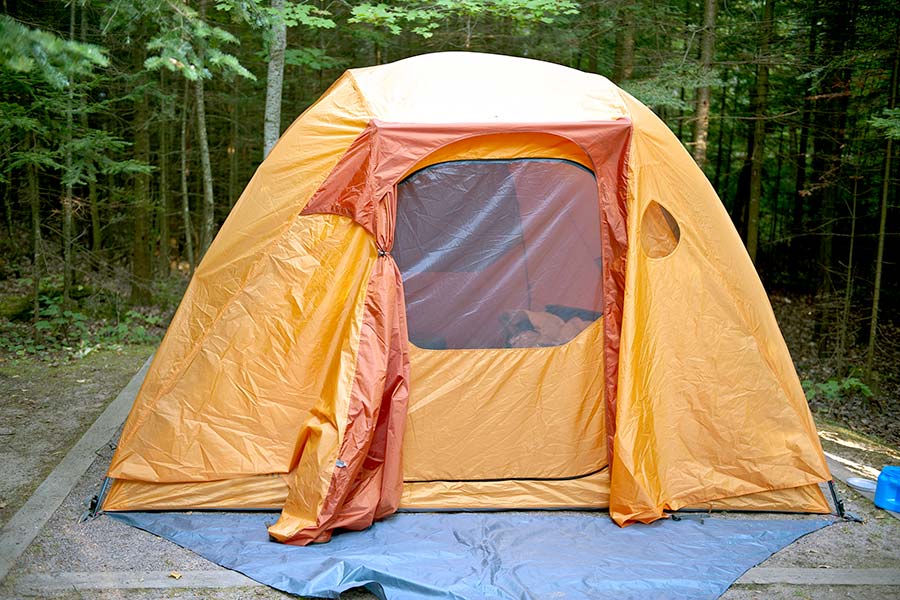
The benefits of using a tent pad are simple; you have a flat, level area to pitch your tent to ensure a better night’s sleep. Rather than wandering around a campsite trying to find the flattest, levelest area to put your tent, the campground has done the work for you. The best place to pitch your tent has already been established.
If you have ever pitched your tent in a less than ideal spot, you know how bad the night can go. You frequently wake up throughout the night because you keep rolling downhill and off your sleeping pad. Or you can’t find a comfortable position because of the root that is digging into your back. Using the tent pad takes away these issues and makes your life much easier when you get to the campsite.
What if No Tent Pad is Available at Your Campsite?
If there is no tent pad at the campsite you are staying at, you will have to find the best place to pitch your tent on your own. Start by looking for an area large enough to fit your tent footprint.
You want the area to be as clear as possible from roots and large rocks. Don’t forget to look overhead to make sure you won’t be sleeping under dead limbs that could fall on your tent.
Next, determine if the site is level enough. It’s okay for the spot to be slightly slanted, but the flatter the better. Typically, if the area is sloping, you’ll want your head to be on the high side, so think about what direction you will need to place your tent on the spot.
Clear the area of any large sticks or rocks that will be uncomfortable to sleep on. You don’t need to go overboard doing this, but a little site maintenance can make a difference in your night’s sleep.
Once you feel good about your spot and have cleared any debris that may be uncomfortable to lay on, pitch your tent.
Why Use a Tent Pad?
A tent pad is going to be the best place to pitch your tent at a campsite. The only time I wouldn’t use a tent pad is if, for some reason, the tent pad has been neglected or destroyed and is no longer a flat, level surface. Otherwise, simply choose which direction you want your door to face and pitch your tent.
If a tent pad is provided, you should always use that area. Not only is it the best spot, but the campground may not want you camping in other areas. The reason that someone selected a particular location could be to keep paths clear or to protect the surrounding vegetation from becoming trampled. Using the same place to pitch a tent helps keep the area around the campsite natural and unspoiled.
Does an RV Site Have a Tent Pad?
Usually, an RV site will not have a tent pad, but some may. Most RV specific sites are equipped with water and electrical hookups and cost more to reserve. At these sites, the campground builds a flat area to park the RV so that you have a level area to sleep, cook, and otherwise hang out.
Since people who reserved RV sites do not typically plan on sleeping in a tent, they do not bother to build out tent pads at these sites. However, if the RV is small, it is convenient for the extra people to have a place to set up a tent beside it.
If you did choose to sleep in a tent at an RV site, your best option would be to pitch your tent where you would otherwise park the RV. The parking site will most likely be the flattest spot at the site. If you want a site with a tent pad, it is best to reserve or ask for a tent site when checking in or booking a campsite.
Final Thoughts
If you plan on pitching a tent, having access to a tent pad is awesome. It provides you a flat, level area to pitch your tent without doing any of the work yourself. You only have to decide which direction you want your tent to face or which way your tent fits best and pitch it.
Of course, if you have an extra-large tent or want to put multiple tents on a tent pad, you may have some complications. If you have an extra-large tent, measure how big your tent is and do some research to ensure your tent will fit on the tent pad provided before booking a campsite.
If you are planning to pitch a tent and can find a campground that has tent pads available to use, that will be your best option. Tent pads will always be the best place for your tent.


